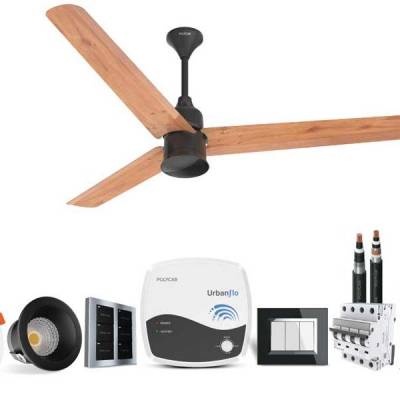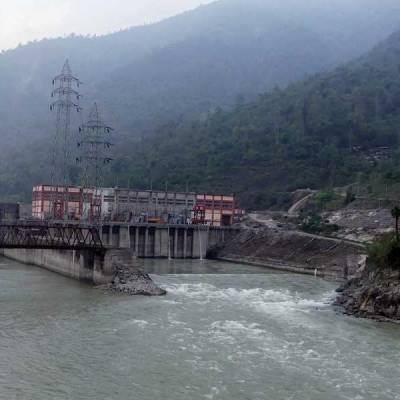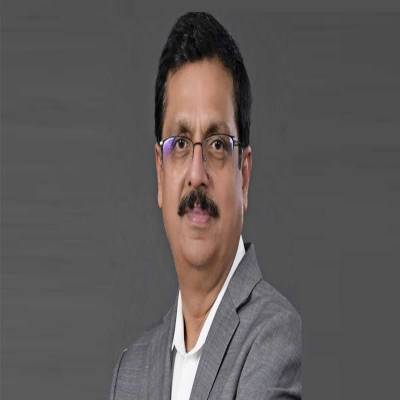- Home
- Infrastructure Energy
- POWER & RENEWABLE ENERGY
- Re-thinking Innovation
Re-thinking Innovation
These are challenging times, particularly for the infrastructure sector. India's GDP, which grew at 8 per cent over the past 10 years, is now at 5 per cent. The rupee has been hit hard owing to a large current account deficit and other domestic factors. Circumstances have been challenging not just in India but all over the world. Also, a diminutive trend has set in where emerging economies are seeing reversals in large capital flows.
Repercussions of slowdown
In this scenario, companies across developed and emerging markets world over have no option but to slash their spending. While there have been several initiatives to kickstart the growth cycle, the pace of recovery is likely to be modest, and the economy faces a long, tough road back. While it is difficult to predict when this slowdown will end, the difficult economic environment motions the need for innovation. Economic downturn leads to many companies pulling down their operations and resources. Most organisations usually cut or cancel capital commitments, lower operating expenses and try to conserve cash by managing the working capital. They try to reduce exposure to risk and refocus on core businesses. However, during these times, consumer preferences also change and it is thus important to identify what consumers want and put in efforts to create innovative products that meet their need.
An innovative approach
In India, the pace of absorption of new technology by domestic manufacturers has been slow. The country has not witnessed any major innovations in terms of new products or technologies, except in a few sectors.
Within the power transmission and distribution sector, companies need to look at innovative methods to cut costs and improve efficiency within the organisation and work processes. These practices will allow them to stay in the game. During difficult and disruptive periods, KEC´s focus has been on improving the quality, cost and supply chain.
We have expanded our business to various international locations (50 plus countries) and our international revenue is more than 50 per cent of the turnover. The company has also started exporting cables to 41 countries including Latin America. Further, we have expanded into new businesses including railways and water and undertook capacity expansions in our Mexico and Butibori facilities. Another type of innovation could also be in terms of optimising costs. Companies need to be very thoughtful about how they approach innovation, because the margin for error decreases as times get tough.
The way forward
To get innovation going, it is essential that we foster collaborative efforts across the sector. Collaborative innovation is possible only if it is driven or backed by the government or a government-owned agency who will be a major user of the technology. The government should look at facilitating this by financing a consortium of companies, which come together for any specific project. An excellent example in this case is the development of the 1,200 kV National Test Station at Bina in Madhya Pradesh, established by Power Grid Corporation of India Ltd (PGCIL). This has been a unique collaborative effort wherein leading manufacturers joined hands with PGCIL to indigenously develop the technology for transmitting power at 1,200 kV. Such collaborations can largely benefit the industry.
Drivers of innovation
There is a dearth of skilled and employable manpower, which is technically competent, equipped with skills and ready to be deployed. A learned and skillful workforce can drive innovation. They can use innovative methods of doing day-to-day operations. There is an urgent need to promote greater linkages and interface between the industry and academia, which require a greater role from three critical agencies technical educational institutes, industry and the government. For instance, by strengthening Industrial Training Institutes (ITIs) through Public-Private Partnership, programmes can be devised for upgrading skills at technical institutions for both faculty and students. In FY11, we adopted an ITI at Ashti village near Nagpur and undertook several initiatives comprising infrastructure improvement, course content upgradation and competence enhancement of instructors. Since then, we have been recruiting apprentices from the ITI for our Jabalpur tower manufacturing facility.
Using underutilised capacities
Global markets hold several opportunities for Indian electrical equipment manufacturers. The country´s electrical equipment sector already has an emerging reputation for sourcing base products and components. India´s exports of electrical equipment were around US$ 4.9 billion in 2012-13, but it was less than 1 per cent of the global trade in electrical equipment. Indian manufactures must take advantage of this opportunity in emerging global markets. We need to formulate strategies for export market diversification and develop country-specific export strategies to build on the intrinsic strengths of the industry. This will largely help Indian manufacturers in using their underutilised capacity on account of the sluggish domestic demand.
Innovation priorities
The road ahead is filled with many challenges and opportunities. To make the power sector an engine of economic growth, both the government and industry need to work together. While the government´s responsibility is to facilitate infrastructure, promote the country´s capabilities, create a favourable and predictable business environment and promote innovation, the industry on the other hand has to work towards designing and manufacturing quality products, improving productivity and maintaining costs. The industry also needs to focus on benchmarking itself with global quality norms. It needs to rapidly absorb new technologies and undertake continuous innovation to meet the evolving global standards for efficiency. It is the right time that we rethink our innovation priorities. Only by redefining the emphasis of our innovation efforts will it be possible to reliably increase return on investment and shorten payback cycles beyond the odd blockbuster.
About the author
: Ramesh Chandak is the Managing Director & CEO of KEC International Ltd, a billion dollar infrastructure EPC company operating globally. Recognised as a turnaround specialist, Chandak has worked in multiple industries across geographies. He has transformed KEC into one of the world´s largest transmission line construction companies by taking its turnover from Rs 500 crore in 2002 to about Rs 6,000 crore in 2012, with almost half of its sales being generated from international operations.
RAMESH CHANDAK highlights the impact of the current economic downturn and innovative ways to win over it. These are challenging times, particularly for the infrastructure sector. India's GDP, which grew at 8 per cent over the past 10 years, is now at 5 per cent. The rupee has been hit hard owing to a large current account deficit and other domestic factors. Circumstances have been challenging not just in India but all over the world. Also, a diminutive trend has set in where emerging economies are seeing reversals in large capital flows. Repercussions of slowdown In this scenario, companies across developed and emerging markets world over have no option but to slash their spending. While there have been several initiatives to kickstart the growth cycle, the pace of recovery is likely to be modest, and the economy faces a long, tough road back. While it is difficult to predict when this slowdown will end, the difficult economic environment motions the need for innovation. Economic downturn leads to many companies pulling down their operations and resources. Most organisations usually cut or cancel capital commitments, lower operating expenses and try to conserve cash by managing the working capital. They try to reduce exposure to risk and refocus on core businesses. However, during these times, consumer preferences also change and it is thus important to identify what consumers want and put in efforts to create innovative products that meet their need. An innovative approach In India, the pace of absorption of new technology by domestic manufacturers has been slow. The country has not witnessed any major innovations in terms of new products or technologies, except in a few sectors. Within the power transmission and distribution sector, companies need to look at innovative methods to cut costs and improve efficiency within the organisation and work processes. These practices will allow them to stay in the game. During difficult and disruptive periods, KEC´s focus has been on improving the quality, cost and supply chain. We have expanded our business to various international locations (50 plus countries) and our international revenue is more than 50 per cent of the turnover. The company has also started exporting cables to 41 countries including Latin America. Further, we have expanded into new businesses including railways and water and undertook capacity expansions in our Mexico and Butibori facilities. Another type of innovation could also be in terms of optimising costs. Companies need to be very thoughtful about how they approach innovation, because the margin for error decreases as times get tough. The way forward To get innovation going, it is essential that we foster collaborative efforts across the sector. Collaborative innovation is possible only if it is driven or backed by the government or a government-owned agency who will be a major user of the technology. The government should look at facilitating this by financing a consortium of companies, which come together for any specific project. An excellent example in this case is the development of the 1,200 kV National Test Station at Bina in Madhya Pradesh, established by Power Grid Corporation of India Ltd (PGCIL). This has been a unique collaborative effort wherein leading manufacturers joined hands with PGCIL to indigenously develop the technology for transmitting power at 1,200 kV. Such collaborations can largely benefit the industry. Drivers of innovation There is a dearth of skilled and employable manpower, which is technically competent, equipped with skills and ready to be deployed. A learned and skillful workforce can drive innovation. They can use innovative methods of doing day-to-day operations. There is an urgent need to promote greater linkages and interface between the industry and academia, which require a greater role from three critical agencies technical educational institutes, industry and the government. For instance, by strengthening Industrial Training Institutes (ITIs) through Public-Private Partnership, programmes can be devised for upgrading skills at technical institutions for both faculty and students. In FY11, we adopted an ITI at Ashti village near Nagpur and undertook several initiatives comprising infrastructure improvement, course content upgradation and competence enhancement of instructors. Since then, we have been recruiting apprentices from the ITI for our Jabalpur tower manufacturing facility. Using underutilised capacities Global markets hold several opportunities for Indian electrical equipment manufacturers. The country´s electrical equipment sector already has an emerging reputation for sourcing base products and components. India´s exports of electrical equipment were around US$ 4.9 billion in 2012-13, but it was less than 1 per cent of the global trade in electrical equipment. Indian manufactures must take advantage of this opportunity in emerging global markets. We need to formulate strategies for export market diversification and develop country-specific export strategies to build on the intrinsic strengths of the industry. This will largely help Indian manufacturers in using their underutilised capacity on account of the sluggish domestic demand. Innovation priorities The road ahead is filled with many challenges and opportunities. To make the power sector an engine of economic growth, both the government and industry need to work together. While the government´s responsibility is to facilitate infrastructure, promote the country´s capabilities, create a favourable and predictable business environment and promote innovation, the industry on the other hand has to work towards designing and manufacturing quality products, improving productivity and maintaining costs. The industry also needs to focus on benchmarking itself with global quality norms. It needs to rapidly absorb new technologies and undertake continuous innovation to meet the evolving global standards for efficiency. It is the right time that we rethink our innovation priorities. Only by redefining the emphasis of our innovation efforts will it be possible to reliably increase return on investment and shorten payback cycles beyond the odd blockbuster. About the author : Ramesh Chandak is the Managing Director & CEO of KEC International Ltd, a billion dollar infrastructure EPC company operating globally. Recognised as a turnaround specialist, Chandak has worked in multiple industries across geographies. He has transformed KEC into one of the world´s largest transmission line construction companies by taking its turnover from Rs 500 crore in 2002 to about Rs 6,000 crore in 2012, with almost half of its sales being generated from international operations.




















